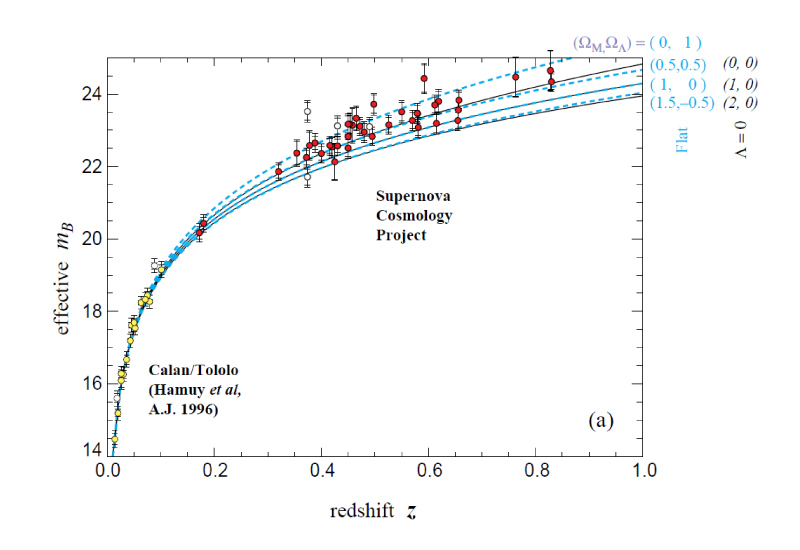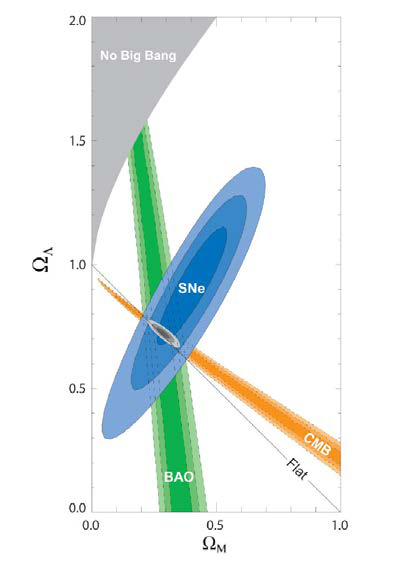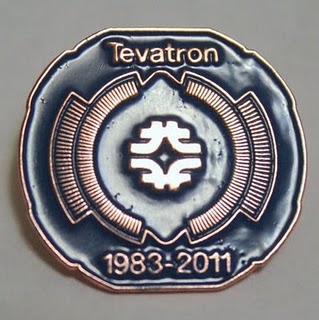And the prize goes to…
Tags:
The 2011 Nobel Prize in Physics goes to Saul Perlmutter, Brian P. Schmidt, and Adam G. Riess for measuring the acceleration of the universe with supernovae.
These American-born scientists ran two competing groups, the Supernova Cosmology Project started in 1988 and the High-z Supernova Search Team in 1994, which independently published breakthrough papers in 1998. The motivation for their projects was based on one of the most vexing problems in astronomy: when you look at a star, can you tell how far away it is? Obviously, they will appear dimmer the farther away they are, so if we know how bright the star really is we can guess its distance fairly accurately. One classic solution to this problem which has been used since the 1930’s is to look for giant, pulsating Cepheid variable stars where we can infer their brightness based on the time between pulses. These teams pioneered the use of Type Ia supernovae which are short-lived but extremely bright, meaning that they will be visible from far away. They used telescopes with CCD sensors which power all of today’s digital cameras to scan a huge patch of sky, then they re-scan the same region a few weeks later to look for signals of a supernovae. The key to this technique was that when they performed the re-scanned they would also book time at other, more powerful telescopes to zoom in on the supernovae they found. Both teams were in fierce competition, often even using the same telescopes.

Brightness versus distance of supernovae. The blue dashed lines show accelerating universe models, while the solid black lines have no acceleration.
The second figure 1 (nobody’s perfect) from the summary paper shows brightness versus distance data of supernovae. The lines show various universe models with different parameters. These models take Einstein’s General Relativity equations and solve them assuming that the universe is completely homogenous and isotropic (which actually disagrees with current observations showing clusters, filaments, and voids, but these complications make the math unsolvable so we’re pretty much stuck). We then throw in different ingredients such as matter which likes to stick together with gravity, radiation, and an outward expansion from a cosmological constant called dark energy. The non-accelerating models with solid black lines show universes with differing amount of matter but no dark energy. We might expect to be on the (1,0) line, but that disagrees with the data. Instead, the blue dashed lines showing accelerating universes fit quite well, and seems to improve by increasing the ratio dark energy to matter.

Combination of results from supernovae (SNe), COBE and WMAP satellites (CMB), and spatial correlations of galaxies (BAO).
These measurements were a new take, and an interesting confirmation of, a result from the COBE satellite launched in 1989 to measure the background radiation left over from the Big Bang (but that’s another story), which incidentally won the 2006 Nobel Prize. (One of the winners, George Smoot, later appeared on “Are You Smarter Than a 5th Grader” where he beat their brains out. High fives all around.) When you compare the COBE results to the supernovae results, something truly remarkable emerges. The overlap of agreement leaves a teeny, tiny allowed region of a nearly-flat, accelerating, forever-expanding universe with roughly 75% dark energy and 25% matter. (Curiously, the matter that we know of is only a small fraction of this, so we call most of this dark matter.)
Personally, the most interesting thing about these results is that they starkly reveal how little we actually know about the universe. We know almost nothing about dark energy, and very little about dark matter. The stuff that we know about comprises about 4% of the universe. 4 lousy percent! This is 1/25th of the universe. Contrary to popular belief, we aren’t nailing down the details of the details of the details of the answers, instead we’re just now trying to figure out what questions we should be asking (see this fantastic animation from PhD Comics for more). Frankly, this makes the universe a much more interesting place to be.
-Dr. D

